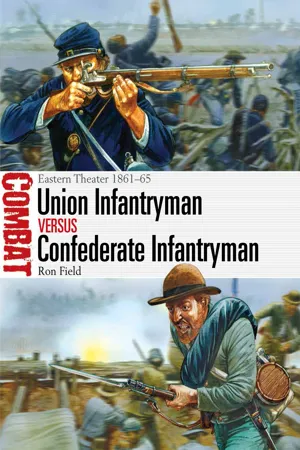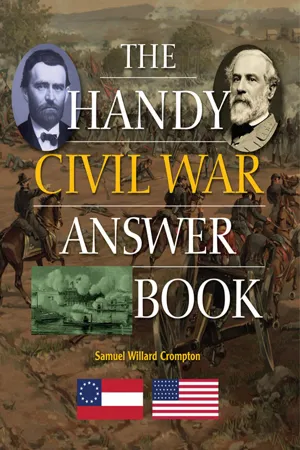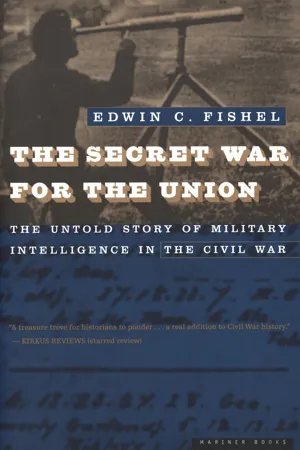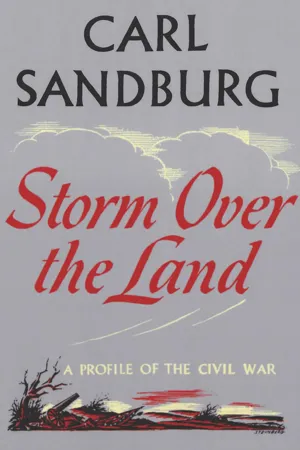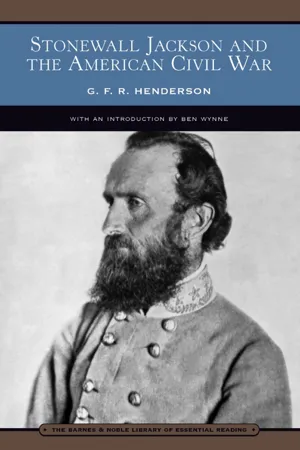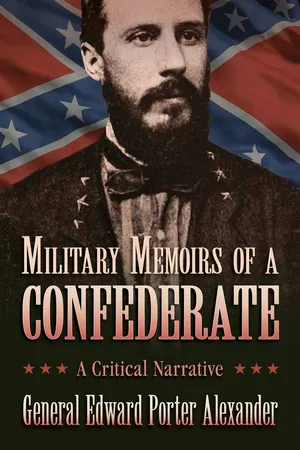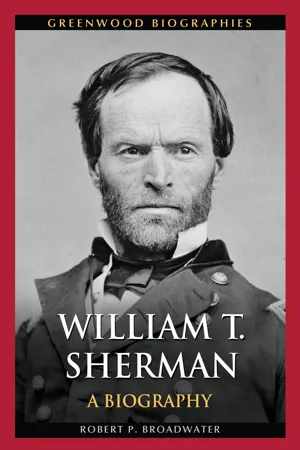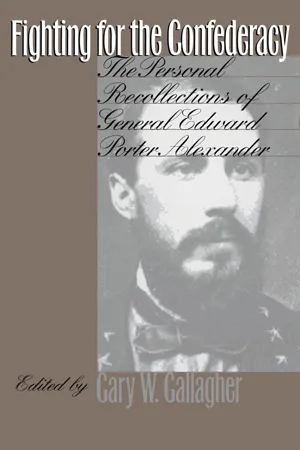History
First Battle of Bull Run
The First Battle of Bull Run, also known as the First Battle of Manassas, was the first major battle of the American Civil War. It took place on July 21, 1861, near Manassas, Virginia. The Confederate victory shattered the Union's hopes for a quick end to the conflict and demonstrated that the war would be long and costly.
Written by Perlego with AI-assistance
Related key terms
Related key terms
1 of 4
Related key terms
1 of 3
10 Key excerpts on "First Battle of Bull Run"
- eBook - ePub
Union Infantryman vs Confederate Infantryman
Eastern Theater 1861–65
- Ron Field, Peter Dennis(Authors)
- 2013(Publication Date)
- Osprey Publishing(Publisher)
First Bull Run/Manassas
July 21, 1861
BACKGROUND TO BATTLE
In the early days of the Civil War, the aged General-in-Chief, Lt Gen Winfield Scott, proposed a strategy to force the Southern States back into the Union which had two prominent features. First, all ports in the seceding states were to be rigorously blockaded by the Union Navy. Secondly, a strong force of about 80,000 infantrymen should use the Mississippi River as a route to thrust completely through the Confederacy. Scott estimated that manpower and resources for what became known as the “Anaconda Plan” would not be ready until the fall of 1861. His critics called for an immediate overland campaign directed primarily at Richmond, Virginia, established as the Confederate capital on May 30, 1861. Their stated belief was that if a few Southern cities and strongholds were taken, the Confederacy would collapse. Hence, the Union campaign leading to the First Battle of Bull Run/Manassas was very much driven by Northern public opinion. The “Forward to Richmond” campaign was conducted by the New York Herald, a Radical Republican newspaper whose editor Horace Greeley did much to pressurize the commander in the field, Brig Gen Irwin McDowell, into advancing on Richmond before his army was ready. As a result, the newly inaugurated President Abraham Lincoln asked the loyal Northern and Border states on April 15, 1861, for 75,000 militiamen for 90 days’ service to put down the rebellion. Still influenced by Scott’s original strategy, each of the regiments received into Federal service was to be either infantry or riflemen. Thus, the part-time Northern soldiery, supplemented by volunteers with little or no military experience, were expected to defend the Union and bring the Southern slave states to heel within three months.Commanding the Army of Northeastern Virginia with 30,600 men at his disposal, Brig Gen McDowell was instructed to attack the Confederate forces of Brig Gen P.G.T. Beauregard’s Army of the Potomac, amounting to 20,000 men, and drive them from the vital railroad junction at Manassas, Virginia. Meanwhile, Maj Gen Robert Patterson was ordered to advance from Harrisburg, Pennsylvania, with 18,000 men in order to keep the 12,000 Confederate troops under Brig Gen Joseph E. Johnston’s Army of the Shenandoah in the Shenandoah Valley and unable to reinforce Beauregard at Manassas. - eBook - ePub
- Samuel Willard Crompton(Author)
- 2014(Publication Date)
- Visible Ink Press(Publisher)
The landscape was quite different from what the men knew; the social and economic differences between the North and the South became readily apparent. Instead of towns and villages, they found plantations and hamlets, with more real living space than expected, but many people living in mild poverty. Another eye-opener had to do with the federal troops themselves: they were, for the most part, in poor physical condition. Americans of 1861 worked harder and longer than their descendants today, but even farm boys were not accustomed to long walks: they rode hay wagons whenever possible. Therefore, as the federal troops moved into the Virginia countryside, they experienced exhaustion and the occasional case of heat stroke.Where were the Confederates?
Led by General P. G. T. Beauregard—the hero of Fort Sumter—the 30,000-odd Confederates were poised in a defensive position near the stream called Bull Run, which meandered through the fields to flow into the Potomac. Three miles behind them was Manassas Junction, the most important railroad connection in this part of the Southern states. Holding that railway link was vital to the Southern cause.Another 20,000 or so Confederates were in the Shenandoah River Valley, about eighty miles away, but they were shadowing, and being shadowed by, a Union force of almost 30,000. Although we know a lot of the numerical strengths and weaknesses, they were not always apparent at the time, not even to the generals on the ground. This led to a lot of false numbers being circulated and a lot of false claims after the first battle was fought.Was Bull Run the first battle of the war?
One can argue the point because there were events such as the capture of Camp Jackson in St. Louis, as well as the engagement at Big Bethel, on the Yorktown Peninsula, both of which came earlier. But in terms of a true battle, pitting true armies, Bull Run was certainly the first battle of the war.Bull Run was also emblematic of the war in many respects. Men on the ground knew little, and their commanders knew only a little more. Smoke obscured parts of the battlefield, and it was nearly impossible for a commanding general to learn all that was happening. Much depended on guesswork, timing, and luck.What was General McDowell’s plan?
Irvin McDowell had been forced into this battle by the insistence of President Lincoln. McDowell drew up a very solid plan of attack, nevertheless. On the evening of July 20, 1861, he stood with his brigade and division commanders, going over the maps a number of times. - eBook - ePub
The Routledge Sourcebook of Religion and the American Civil War
A History in Documents
- Robert R. Mathisen(Author)
- 2014(Publication Date)
- Routledge(Publisher)
Chapter 2 From First Manassas/Bull Run to the Ironclads July 1861 to March 1862DOI: 10.4324/9780203767610-2“Already God’s hand is seen in the reverse. It was needed: it is working well. May it work completely!” —Rev. John F. W. Ware July 28, 1861“God has granted us a triumph which must resound through the civilized world.” —Rev. Stephen Elliott July 28, 1861Both sides in the Civil War believed God was on their side and that they were doing battle for the Lord. For that reason, it was a holy war being fought for a righteous cause. And that was the sentiment expressed by both sides as the dust settled in the aftermath of the first significant battle of the war, fought at Bull Run (or Manassas, as it was known in the South) on Sunday, July 21, 1861.During the week following the Confederacy’s decisive victory at Manassas, ministers had much to ponder as they prepared their sermons for the coming Sunday. For the first of what would be many times during the war, preachers crafted their comments to fit the circumstance. In doing so they had to address certain questions that would be asked and debated throughout the conflict. What did victory mean? And what about a defeat? Was God—could God—be present in both?When Unitarian minister John F. W. Ware addressed his Boston congregation the Sunday after the Union’s loss at Bull Run, he included the word “reverse” in the title of his sermon. This word would be used commonly by both sides as a euphemism for defeat. A battle lost was merely an occasion to reverse the direction being taken by the armies, and by the people back home. Ware understood the Union’s Bull Run loss as evidence of God’s chastisement for the national sin of slavery, and within one short week he believed God’s hand was seen in the reversal. It had done the work of “purging away all low motive; cleansing our councils of all but patriotism and faith; our armies of all but courage and honor, ourselves of all but conviction of the holiness of our cause, and confidence in God.” - eBook - ePub
- Charles E. Heller, William A. Stofft(Authors)
- 2021(Publication Date)
- University Press of Kansas(Publisher)
67Other lessons, too, were derived from the First Battle of Bull Run. Formerly lax in the extreme, training and discipline showed marked improvement in both armies after 21 July. Because no officially sanctioned program of training was ever promulgated by the war departments of either North or South, responsibility for training resided at a relatively low level throughout the war. There, experience proved to be a great teacher. For those officers present, Bull Run provided a stern object lesson in what could happen when inadequately trained and poorly disciplined troops took the field. When the veterans of the battle moved on to other commands, their experiences at Bull Run remained vivid, and they incorporated that hard-won wisdom into their training schedules. As a result, the new volunteer regiments would undergo much more rigorous drilling than had those which fought in July 1861. Target practice still tended to be haphazard, but at least the new formations would be better able to march and maneuver under fire the next time battle was joined. No matter how high they rose in rank, some officers never forgot this lesson of Bull Run. In fact, William T. Sherman, one of those who had stormed Henry House Hill, as a corps commander instituted one of the best training programs seen in the Federal Army during the conflict. Others less renowned than Sherman responded in similar fashion.68In terms of organizational structure, McDowell’s creation of divisions to facilitate command-and-control proved to be a step in the right direction, although its advantages were not readily apparent on 21 July. Not long after taking command, McClellan established a formal brigade structure with regiments permanently assigned to particular brigades. The Confederate brigade structure crystallized along similar lines, with regiments from the same state usually being brigaded together, unlike Federal practice. In mid-October, McClellan established a formal division structure (with McDowell as a division commander), and in 1862 he arranged the divisions into army corps. These changes, too, soon were adopted by the Confederates. Under the new Federal structure, artillery batteries were assigned to divisions rather than to infantry brigades in hopes that greater concentrations of firepower might be achieved when necessary. Confederate artillerists took this concept one step further in 1863 by grouping their batteries into battalions, which were then assigned to army corps. Federal gunners adopted a similar organization shortly thereafter. In each case, the reorganization was made to improve the potential value of artillery on a battlefield where changing technology had threatened to render artillery impotent.69 - eBook - ePub
The Secret War for the Union
The Untold Story of Military Intelligence in the Civil War
- Edwin C. Fishel(Author)
- 2014(Publication Date)
- Mariner Books(Publisher)
2First Bull Run
June–July 1861IN THE FIRST MAJOR CAMPAIGN of the Civil War, which ended in humiliating defeat on Bull Run on that unforgettable Sunday, July 21, the Federals had little information that could be called intelligence. On one key question—how serious an obstacle was presented by Bull Run itself—they settled for an easy assurance that the stream was easily fordable, and they paid a heavy price for the lack of advance investigation. On another question—whether the Confederates were bringing their Shenandoah Valley army to add to the force on Bull Run—the Federals blundered away their opportunities to provide their Bull Run commander, Brigadier General Irvin McDowell, with timely warning of the oncoming enemy reinforcement. The result was that McDowell received word of it too late to change his plans or bring up his own reserves. The reinforcing brigades from the Valley turned a Federal advantage into a Confederate victory.These failures were the predictable outgrowth of the lack of intelligence preparedness, combined with haste. The Bull Run campaign was the Lincoln administration’s response to the now familiar “On to Richmond!” cry from Congress, the press, and the Northern public. The high command yielded to the pressure and ended up adding to it, overriding McDowell’s warnings about the greenness and general unreadiness of his army.1Beauregard’s army on Bull Run, protecting a rail junction at Manassas, only thirty miles from Washington, was not the Federals’ only concern in northern Virginia. There was also the Confederate army in the Shenandoah Valley, originally placed defiantly at its mouth on the Potomac, at Harper’s Ferry, and moved in mid-June to Winchester. General McDowell assembled an army at Washington to oppose the Rebels at Manassas; another force of green Federals gathered in south-central Pennsylvania with a view to marching down into Virginia and reclaiming the Valley for the Union. When that movement was about ready, McDowell was directed to work up a plan to assist the Valley campaign by marching northwest up the Virginia side of the Potomac. He answered with a studied paper showing that such a march would expose his left flank to the Confederates on Bull Run, and without any compensating military gain.2 - eBook - ePub
Storm Over the Land
A Profile of the Civil War
- Carl Sandburg(Author)
- 2015(Publication Date)
- Mariner Books(Publisher)
CHAPTER 4First Battle of Bull Run
THE Confederate Government, strengthened by the finally seceded States of Arkansas, Tennessee, North Carolina, and Texas, had moved the last week in May from Montgomery, Alabama, to Richmond, Virginia, to be nearer the Border States and the expected heavy fighting. Into Richmond streamed regiments from all parts of the South. The cry in the South, “On to Washington!” snarled straight into the cry from the North, “On to Richmond!”Among troops at Richmond were farmers and hillmen who never owned a slave nor an acre of ground, and young men from the First Families where a thousand acres and a hundred slaves was the unit. Dapper companies with shining blouses, brass buttons, uniform rifles of recent make, were regimented with other companies in butternut jeans, carrying shotguns and squirrel rifles.The Richmond, Virginia, State House, where the Confederate Congress held sessionsSecession map, South Carolina December 20, 1860, Tennessee June 8, 1861. From Albert Shaw’s Abraham Lincoln, Year of His Election .From the Potomac River to the Gulf Coast and out where the Rio Grande trickled over New Mexico ran the recruiting ground of this Confederate Army. Its line zigzagged 1,500 miles from Chesapeake Bay through Kentucky and out to the corners of Kansas. Its brain and will centered in the capitol, the executive mansion, the departments, at Richmond. Its chief weapon of defense was an army of 100,000 troops. The controls of this Government were out of the hands of those who had first given it breath and fire. Rhett of the True Perpetual Separationists was now only a member of the Confederate Congress. The movement to elect him President and the efforts to appoint him Secretary of War had both failed.Women of the period. All of the soldiers had mothers and many had sisters and wives. Photographs by Brady and designated as Miss Mundelle (upper left ), Mrs. Chapin (upper right ), not named (lower left ), Mrs. Cory (lower right - eBook - ePub
- G. F. R. Henderson(Author)
- 2009(Publication Date)
- Barnes & Noble(Publisher)
And Jackson’s attitude was that of the Southern people. When the news of Bull Run reached Richmond, and through the crowds that thronged the streets passed the tidings of the victory, there was neither wild excitement nor uproarious joy. No bonfires lit the darkness of the night; no cannon thundered out salutes; the steeples were silent till the morrow, and then were heard only the solemn tones that called the people to prayer. It was resolved, on the day following the battle, by the Confederate Congress: “That we recognise the hand of the Most High God, the King of kings and Lord of lords, in the glorious victory with which He has crowned our arms at Manassas, and that the people of these Confederate States are invited, by appropriate services on the ensuing Sabbath, to offer up their united thanksgivings and prayers for this mighty deliverance.”The spoils of Bull Run were large; 1,500 prisoners, 25 guns, ten stand of colours, several thousand rifles, a large quantity of ammunition and hospital stores, twenty-six wagons, and several ambulances were left in the victors’ hands. The Federal losses were 460 killed and 1,124 wounded; the Confederate, 387 killed, 1,582 wounded, and 13 missing. The First Brigade suffered more severely than any other in the Southern army. Of 3,000 officers and men, 488 were killed or wounded, nearly a fourth of the total loss.A few days after the battle Johnston advanced to Centreville, and from the heights above the broad Potomac his cavalry vedettes looked upon the spires of Washington. But it was in vain that the Confederate troopers rode to and fro on the river bank and watered their horses within sight of the Capitol. The enemy was not to be beguiled across the protecting stream. But it was not from fear. Although the disaster had been as crushing as unexpected, it was bravely met. The President’s demand for another army was cheerfully complied with. Volunteers poured in from every State. The men were no longer asked to serve for three months, but for three years. Washington became transformed into an enormous camp; great earthworks rose on the surrounding heights; and the training of the new levies went steadily forward. There was no cry for immediate action. Men were not wanting who believed that the task of coercion was impossible. Able statesmen and influential journalists advised the President to abandon the attempt. But Lincoln, true to the trust which had been committed to his keeping, never flinched from his resolve that the Union should be restored. He, too, stood like a wall between his defeated legions and the victorious foe. Nor was the nation less determined. The dregs of humiliation had been drained, and though the draught was bitter it was salutary. The President was sustained with no half-hearted loyalty. His political opponents raved and threatened; but under the storm of recrimination the work of reorganising the army went steadily forward, and the people were content that until the generals declared the army fit for action the hour of vengeance should be postponed. - eBook - ePub
Military Memoirs of a Confederate
A Critical Narrative
- Edward Porter Alexander(Author)
- 2014(Publication Date)
- Skyhorse(Publisher)
P.M. We shall see that not only every day of that delay, but even every hour of it, was essential to the Confederate victory which resulted.So on my arrival at Manassas, July 2, there was really more time to install the signals than I expected, for “rumors of the foe’s advance” now swelled upon almost every breeze. I had brought with me from Richmond all necessary equipment and I had only to select men and train them. I soon made acquaintances and got the names of some intelligent privates, who might later be promoted. I had these detailed and put upon a course of instruction and practice. Meanwhile I procured a horse, and between times began an exploration of the country to find what facilities it offered for lines of signals.The topography was far from favorable. Our line of battle had been chosen behind the stream of Bull Run, about three miles north of Manassas, and the course of the stream was generally wooded and bordered with small fields and pastures, giving few open stretches. I was not sanguine of rendering any valuable service, but fortunately had time to examine the country, and, as will be seen, the line was found which disclosed the enemy’s attack in time to defeat it.About a mile east of Manassas, on the farm of a Mr. Wilcoxen, was a high rocky point having a good outlook over a valley to the north and west. I made this point a central station, and by a little clearing here and there got two straight six-mile ranges. One was northwest to a bluff over Bull Run valley on our extreme left, near the house of Van Ness, just above the Stone Bridge by which the Warrenton Turnpike crossed Bull Run. The other was north, to Centreville, about three miles beyond the Run, opposite our centre. A third station was found near the house of McLean, opposite our right centre, and a fourth near our headquarters at Centreville. This was the utmost the topography permitted, and the men were encamped at the stations and set to practising by day and night. - eBook - ePub
William T. Sherman
A Biography
- Robert P. Broadwater(Author)
- 2013(Publication Date)
- Greenwood(Publisher)
Chapter 7
BULL RUN
Regiment after regiment marched out of Washington to the sound of martial airs played by their bands. Julia Ward Howe watched with patriotic excitement as the bands and throngs of men gaily went forward to what most of them thought would be a great adventure. Julia listened as one of the bands played an old revival tune that caught her fancy. She would later add words to the melody, and the resulting song “The Battle Hymn of the Republic” would become the anthem of the Northern armies. The march of the Union army toward Manassas was a slow and tedious process, however. The men in the ranks were not accustomed to moving in large formations, having not yet mastered the intricate maneuvers of army drill. The heat was stifling, and the dust raised from the unpaved road by horses, wagons, and tens of thousands of marching feet filled the air with a choking cloud that made it hard for the men to breathe. Thousands of footsore and exhausted men fell out of the ranks to lay prostrate along the sides of the road. Wild blackberry bushes were to be found along the line of march, and many other soldiers bolted from their places in the ranks to pick the refreshing berries. Cump was dismayed by the actions of the soldiers. He said that “The march demonstrated little to save the general laxity of discipline; for with all my personal efforts I could not prevent the men from straggling for water, blackberries, or any thing on the way they fancied.” At the end of two days of marching, Colonel David Hunter’s Second Division arrived at Fairfax Courthouse, Virginia, little more than 20 miles from Washington.The slow pace of the Union army foiled McDowell’s plans thus far. He intended to take the Confederate garrison at Fairfax by surprise, but the defenders had ample time to make good their escape. Col. Samuel P. Heintzelman’s Third Division had skirted the town, and marched toward Bull Run, in an effort to develop the Confederate right flank. General Tyler’s division, of which Sherman’s brigade was a part, was behind Hunter’s in the line of march, and upon reaching Fairfax Courthouse, Tyler was ordered to march on through the town, toward Centreville, and the fords of Bull Run Creek beyond. McDowell desired Tyler to make a demonstration against the Confederate position to occupy their attention. In this way, he hoped to be able to mask Heintzelman’s flanking movement from observation. Tyler was ordered to make a noisy and convincing demonstration, but McDowell was quite clear in cautioning him, “Do not bring on an engagement.” Tyler moved his division forward with Col. Israel B. Richardson’s brigade in the lead. Upon reaching Centreville, the bulk of Tyler’s division stopped. Tyler, along with Richardson’s brigade, pushed on toward Blackburn’s Ford on Bull Run Creek. - eBook - ePub
Civil War America
The Personal Recollections of General Edward Porter Alexander
- Gary W. Gallagher(Author)
- 2000(Publication Date)
- The University of North Carolina Press(Publisher)
Chapter 2 FIRST MANASSAS OR BULL RUNI arrived in Richmond Saturday night, June 1, & stopped at the Exchange Hotel. I reported for duty on Monday, & my commission as capt. of engineers was given me dating from [the] date of my resignation from [the] U.S. Army. I was ordered to await orders in Richmond & meanwhile to have a number of signal flags, &c. constructed so as to be ready to put a signal corps into the field on short notice. Mr. Davis remembered me from my having helped Myer exhibit the system to the military committee of the Senate in the winter of 1860-61, as before mentioned.It did not take me long to get a manufactory of all sorts of signal apparatus under way & I reported as ready for orders in a very few days, being anxious to get into the field somewhere. We had armies in process of formation at Norfolk, Yorktown, Fredericksburg, Manassas, Winchester, & somewhere in West Va. besides the western & southern armies. I did not care specially where I was sent & made no special application, leaving it to the War Dept. to say where I could be of most use. I knew of Gen. Bob Garnett’s applying to have me sent with him to West Va. & have ever since considered it a piece of very good luck that he was refused. For he was killed & his whole command routed at Rich Mountain, his first fight, in a very few weeks.1 Meanwhile my orders were put off almost from day to day.Richmond however was very far from dull, for troops from all over the South were arriving every day & resigned Southern officers out of the old army were coming in from every territory, & camps of instruction were formed near the city where raw troops were drilled, loose companies organised into regts. & regiments into brigades, field & staff officers were appointed & assigned, arms & equipments were issued, & as fast as any body was organised & equipped it was sent forward to one of the above named points.My brother Felix2 was at that time private secretary of Mr. Toombs, who was sec. of state—J.H.A.’s regiment, the 9th Geo., came through & went up to Winchester to Gen. Jos. E. Johnston.3 My orders were still delayed from day to day & at last, about the end of June, I decided to telegraph for Miss Teen to come on & join me, as I thought I might be there another month & there was no reason why she should not be with me. She started promptly—under the escort of Dudly Dubose; but, alas! she was met at the station not by myself but by Lewis Webb with the news that I had been sent up to Manassas that very morning. That was our first sample of one of the minor “horrors of war.” I had at last been very suddenly assigned to the staff of Gen. Beauregard,4
Index pages curate the most relevant extracts from our library of academic textbooks. They’ve been created using an in-house natural language model (NLM), each adding context and meaning to key research topics.
Explore more topic indexes
Explore more topic indexes
1 of 6
Explore more topic indexes
1 of 4
